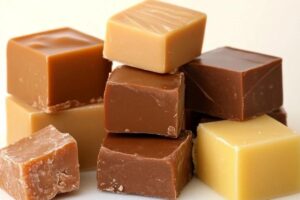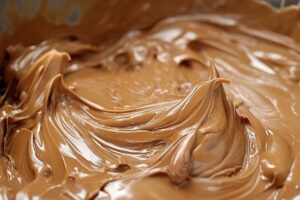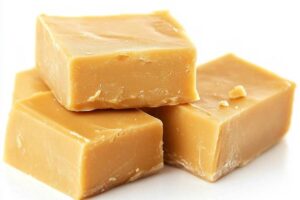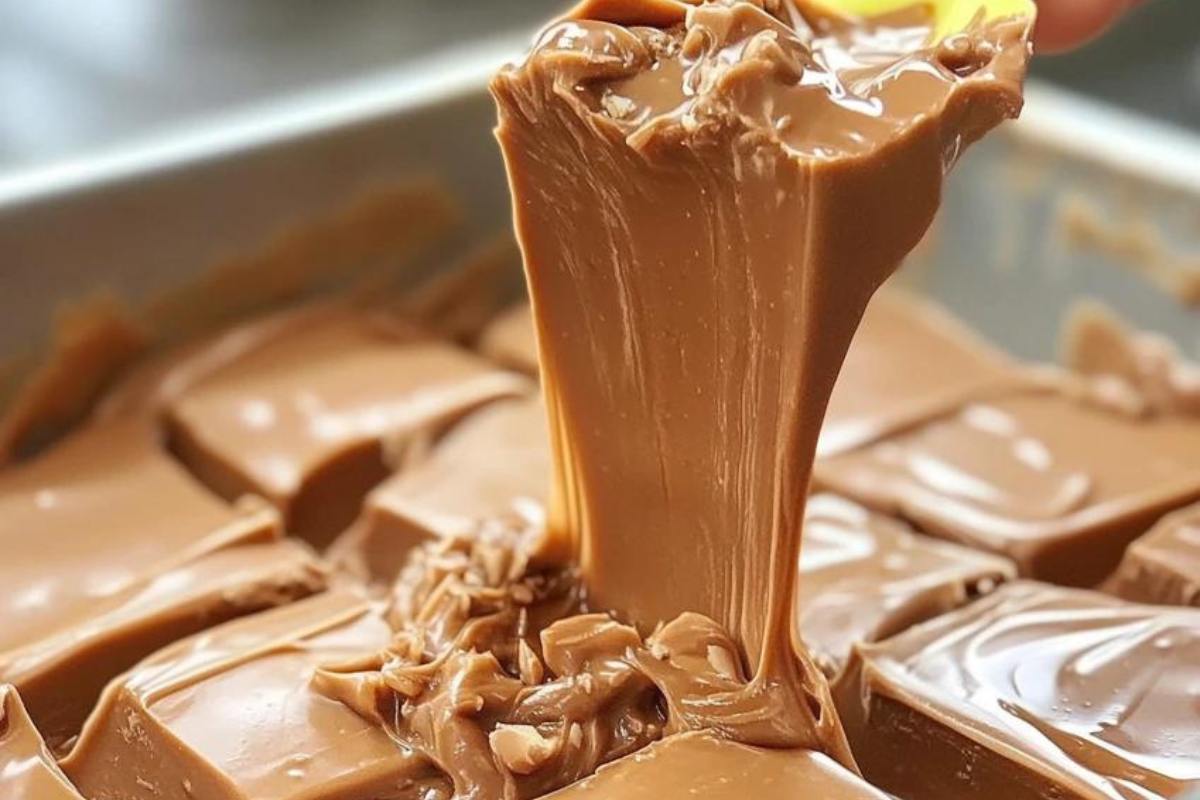The Secret to Smooth Fudge: A Complete Guide
Fudge is a classic, rich dessert that delights with its creamy texture and indulgent sweetness. However, achieving the perfect consistency—smooth, creamy, and free of graininess—can be challenging. Many home bakers struggle with common issues like sugar crystallization, overcooking, or improper cooling. If you’ve ever wondered, “What is the secret to smooth fudge?” this guide will help you perfect your fudge-making technique.
In this article, we will explore the science behind smooth fudge, discuss tips and tricks for mastering it, and provide a step-by-step guide to ensure your fudge turns out perfectly every time. We’ll also cover common mistakes and how to avoid them, along with delicious flavor variations and frequently asked questions.
The Science of Sugar Crystallization
The secret to smooth fudge starts with understanding sugar crystallization. When making fudge, sugar is dissolved in liquid and then heated. If sugar crystals form too early or improperly, it can result in a grainy texture. To create the creamy, smooth fudge texture we all love, controlling how and when sugar crystallizes is crucial.
Sugar crystallization occurs when the sugar molecules bond together during the cooking process. If they bond too quickly, you end up with a gritty or grainy consistency instead of the velvety smooth texture desired. That’s why the cooking temperature, stirring technique, and ingredients are all key factors in preventing premature crystallization. For more insights on sugar control, check out these Foolproof Tips for Smooth Fudge.
Importance of Temperature Control in Fudge Making
Temperature is one of the most critical elements in achieving smooth fudge. The sugar mixture must reach a specific temperature range, known as the soft-ball stage, to ensure the right consistency. Cooking the fudge mixture to 234-240°F (112-116°C) allows the sugar to dissolve properly and creates the creamy texture you’re aiming for.
To do this accurately, using a candy thermometer is highly recommended. A candy thermometer ensures that you don’t overcook or undercook your fudge. If the temperature is too high, the fudge will become too hard or dry. If it’s too low, the fudge won’t set properly, resulting in a runny consistency. For more detailed steps, check out this Ultimate Fudge-Making Guide.
Key Ingredients for Smooth Fudge

Achieving smooth fudge is not only about technique but also about choosing the right ingredients. Here’s a breakdown of the essential ingredients and how they contribute to the fudge’s creamy texture:
- Sugar: The primary ingredient in fudge, sugar provides structure and sweetness. Fully dissolving the sugar is critical to avoiding a grainy texture.
- Butter: Butter adds richness and a smooth mouthfeel. Too little butter can make the fudge dry, while too much may result in a greasy consistency.
- Milk or Cream: Milk (or heavy cream) helps dissolve the sugar and ensures the fudge remains soft and smooth.
- Flavoring Agents: Common flavorings like vanilla, chocolate, or peanut butter enhance the fudge’s taste without affecting its texture.
It’s important to use high-quality ingredients, especially for butter and chocolate, as they can significantly influence the final texture and flavor.
Step-by-Step Guide to Making Smooth Fudge
Now that we’ve covered the science and ingredients, let’s dive into the step-by-step process of making perfectly smooth fudge.
Ingredients:
- 2 cups granulated sugar
- 1/2 cup unsalted butter
- 2/3 cup evaporated milk
- 1 1/2 cups semi-sweet chocolate chips
- 1 teaspoon vanilla extract
Equipment:
- Candy thermometer
- Heavy-bottomed saucepan
- Wooden spoon
- Greased 8×8-inch baking pan
Instructions:
- Prepare Your Ingredients: Gather all your ingredients and have your candy thermometer ready. Fudge requires precision, so having everything prepped before you begin is essential.
- Cooking the Sugar Mixture: In a heavy-bottomed saucepan, combine the sugar, butter, and evaporated milk. Heat the mixture over medium heat, stirring constantly, until the sugar has fully dissolved. Once dissolved, clip your candy thermometer to the side of the pan, ensuring it’s submerged in the mixture but not touching the bottom.
- Reaching the Soft-Ball Stage: Allow the mixture to reach 234-240°F, the soft-ball stage. This is where the magic happens! Do not stir once the mixture is boiling—this prevents premature crystallization, which can lead to grainy fudge.
- Remove from Heat and Add Flavorings: Once the mixture has reached the soft-ball stage, remove it from heat and immediately stir in the chocolate chips and vanilla extract. Stir until smooth and the chocolate has completely melted.
- Cooling and Beating the Fudge: Allow the fudge mixture to cool to around 110°F without stirring. This cooling step is crucial to avoid sugar crystallization. Once cooled, beat the fudge vigorously until it thickens and starts to lose its gloss. Beating at the right time is key to creating a smooth, creamy texture.
- Pour and Set: Pour the fudge into your prepared greased pan. Smooth it out and let it set at room temperature for 2-3 hours. Once set, cut it into squares and enjoy!
Common Mistakes and How to Avoid Them
Even with the best intentions, mistakes can happen while making fudge. Here are some common fudge-making errors and how to fix or avoid them:
- Mistake 1: Over-Stirring During Cooking
Solution: Stir only until the sugar is dissolved, and avoid stirring once the mixture reaches the soft-ball stage. - Mistake 2: Using the Wrong Temperature
Solution: Always use a candy thermometer to ensure the mixture reaches 234-240°F. - Mistake 3: Beating the Fudge Too Early or Late
Solution: Allow the fudge to cool to 110°F before beating. If you beat too early, the fudge will not set properly. Beating too late results in hard fudge.
If you encounter grainy fudge, don’t worry! You can reheat it, add a bit of milk or cream, and try again. For more troubleshooting tips, check out these Secrets to Successful Fudge.
Tricks for Foolproof Fudge
Here are some additional tricks that can help ensure your fudge turns out smooth and creamy every time:
- Use a Candy Thermometer: This cannot be overstated. A thermometer helps you accurately monitor the temperature, preventing over- or undercooking.
- Add Corn Syrup or Marshmallows: These ingredients interfere with sugar crystallization, ensuring a smoother texture.
- Avoid Stirring Too Much: Stirring the mixture while it’s cooling can cause the sugar to crystallize prematurely, resulting in grainy fudge.
Flavor Variations for Smooth Fudge

Once you’ve mastered the technique of making smooth fudge, it’s time to experiment with different flavors to elevate your dessert game. Fudge is incredibly versatile, allowing you to customize it with a variety of ingredients and flavor combinations. Below are some popular and creative flavor variations to inspire your next batch of fudge.
1. Classic Chocolate Fudge
The most traditional and beloved fudge flavor is chocolate. The deep richness of semi-sweet or dark chocolate combined with the creamy fudge base makes this a timeless treat.
- Ingredients: Semi-sweet chocolate chips, vanilla extract, butter, evaporated milk, and sugar.
- Tip: For an even more intense chocolate flavor, try using dark chocolate or adding a pinch of espresso powder.
2. Peanut Butter Fudge
Peanut butter fudge offers a creamy, nutty twist to the classic recipe. This version has a rich peanut butter flavor and a melt-in-your-mouth texture that pairs well with chocolate or can stand alone.
- Ingredients: Peanut butter (smooth or chunky), butter, sugar, and vanilla extract.
- Tip: For a peanut butter and chocolate combo, swirl in some melted chocolate on top before the fudge sets.
3. Mint Chocolate Fudge
If you love the refreshing taste of mint, mint chocolate fudge is a perfect variation. The combination of cool mint and rich chocolate creates a vibrant and irresistible treat.
- Ingredients: Semi-sweet chocolate chips, peppermint extract, green food coloring (optional).
- Tip: Add crushed peppermint candies on top for a festive, crunchy topping.
4. Rocky Road Fudge
For texture lovers, rocky road fudge is an excellent choice. The addition of mini marshmallows, nuts, and chocolate creates a delightful combination of chewy, crunchy, and creamy textures.
- Ingredients: Chocolate chips, mini marshmallows, chopped nuts (like almonds or walnuts).
- Tip: Toast the nuts before adding them to the fudge for an extra layer of flavor.
5. Salted Caramel Fudge
Sweet and salty combinations are always a hit, and salted caramel fudge is no exception. This indulgent version blends rich caramel flavors with a sprinkle of sea salt to balance out the sweetness.
- Ingredients: Caramel sauce, butter, sugar, cream, and sea salt.
- Tip: Drizzle extra caramel on top and sprinkle sea salt just before the fudge sets to enhance the flavor.
6. Cookies and Cream Fudge
If you’re a fan of cookies and cream desserts, this variation will be a hit. Cookies and cream fudge combines crushed chocolate sandwich cookies (like Oreos) with a creamy vanilla fudge base.
- Ingredients: White chocolate chips, crushed sandwich cookies, vanilla extract, butter, and condensed milk.
- Tip: Stir in some extra cookie crumbs at the end for added texture and a more cookie-filled bite.
7. Maple Walnut Fudge
Maple walnut fudge is a classic flavor that combines the sweetness of pure maple syrup with the earthiness of walnuts. It’s a wonderful variation for fall or winter celebrations.
- Ingredients: Pure maple syrup, butter, walnuts, sugar, and cream.
- Tip: Use high-quality maple syrup to ensure a strong maple flavor, and top with chopped walnuts for a decorative finish.
8. Coconut Fudge
For a tropical twist, coconut fudge adds a delightful coconut flavor to the creamy base. You can make this using shredded coconut or coconut extract, or even coconut milk for a more pronounced coconut flavor.
- Ingredients: Sweetened shredded coconut, coconut milk or coconut extract, white chocolate chips, and butter.
- Tip: Toast the shredded coconut before adding it to the fudge for a deeper flavor and extra crunch.
9. Orange Creamsicle Fudge
Inspired by the classic creamsicle ice cream bar, this fudge variation blends the bright citrus flavor of orange with the creamy richness of fudge. It’s a refreshing change from the usual fudge flavors.
- Ingredients: White chocolate chips, orange extract or fresh orange zest, sweetened condensed milk, and vanilla.
- Tip: Swirl in orange food coloring for a visually stunning presentation that mirrors the creamsicle flavor.
10. Mocha Fudge
Mocha fudge is the perfect treat for coffee lovers. The combination of chocolate and coffee creates a rich, bold flavor that pairs wonderfully with the smooth texture of fudge.
- Ingredients: Semi-sweet chocolate chips, instant espresso powder, vanilla extract, butter, and sugar.
- Tip: For an extra touch, sprinkle finely ground coffee beans or chocolate-covered espresso beans on top.
Tips for Customizing Your Fudge
- Swirl Technique: For a more dynamic look and flavor, try swirling different ingredients like peanut butter, caramel, or fruit preserves into your fudge before it sets.
- Add-Ins: Get creative by adding chopped candy bars, toffee bits, or dried fruits like cranberries or cherries to your fudge for extra flavor and texture.
- Flavor Extracts: Beyond vanilla, experiment with different extracts such as almond, coconut, or hazelnut to change up the base flavor of your fudge.
There’s no limit to the different flavor combinations you can create when making fudge. Whether you prefer the classic richness of chocolate fudge or want to try something new like salted caramel or cookies and cream, the possibilities are endless. Experiment with your favorite flavors, and you’ll discover just how versatile smooth fudge can be!
How to Store Fudge for Long-Lasting Smoothness
Once you’ve mastered the art of making smooth fudge, it’s important to store it properly to maintain its texture and freshness. Improper storage can lead to fudge that is either too dry, too hard, or loses its signature creamy texture. Here are the best ways to store fudge so that it stays delicious and smooth for as long as possible.
1. Storing Fudge at Room Temperature
Fudge can be stored at room temperature for up to two weeks, making it a great treat to have on hand. Room temperature storage is ideal for maintaining its smooth and creamy texture, as storing fudge in the refrigerator can sometimes cause it to dry out or harden.
- How to Store:
- Place the fudge in an airtight container to prevent it from absorbing moisture or odors from the surrounding air.
- For added protection, you can wrap individual pieces of fudge in wax paper or parchment paper to keep them separated and ensure they don’t stick together.
- Store the container in a cool, dry place, away from direct sunlight or heat sources.
2. Storing Fudge in the Refrigerator
While storing fudge at room temperature is best for texture, you can also store it in the refrigerator if your kitchen is particularly warm or if you need to store it for longer than two weeks.
- How to Store:
- Wrap the fudge in plastic wrap or wax paper to prevent it from drying out in the fridge.
- Place the wrapped fudge in an airtight container to protect it from picking up any strong smells from other foods in the fridge.
- Before serving, let the fudge sit at room temperature for about 30 minutes to soften and regain its smooth texture.
3. Freezing Fudge for Long-Term Storage
If you’ve made a large batch of fudge or want to keep it for an extended period, freezing is an excellent option. When stored correctly, fudge can be frozen for up to three months without losing its smooth and creamy consistency.
- How to Store:
- First, wrap each piece of fudge tightly in plastic wrap or wax paper. This helps to maintain freshness and prevents freezer burn.
- Place the wrapped fudge in a freezer-safe airtight container or resealable freezer bag. Be sure to remove as much air as possible from the bag before sealing it.
- Label the container or bag with the date so you can keep track of how long it’s been in the freezer.
- When ready to enjoy the frozen fudge, allow it to thaw at room temperature for several hours or overnight. Do not unwrap the fudge until it’s fully thawed to prevent condensation from affecting the texture.
4. Additional Tips for Storing Fudge
- Cut the fudge before storing: It’s easier to store and serve fudge when it’s already cut into bite-sized pieces. This also helps prevent cracking or breaking when you’re ready to enjoy it.
- Avoid stacking fudge: If you’re storing multiple layers of fudge, place a piece of wax paper or parchment paper between the layers to prevent them from sticking together.
- Prevent moisture: Fudge is best kept in dry environments. Exposure to moisture can make it sticky or cause it to lose its firmness.
By following these guidelines, you can ensure your fudge retains its delicious, smooth texture and is ready to enjoy whenever you want. Whether you keep it at room temperature, refrigerate it, or freeze it for later, proper storage is key to keeping your fudge fresh and flavorful.

FAQs About Smooth Fudge
What is the secret to smooth fudge?
The secret to smooth fudge lies in controlling sugar crystallization by cooking the mixture to the right temperature and avoiding over-stirring during the cooling process.
How do I prevent my fudge from turning grainy?
To avoid grainy fudge, ensure that the sugar is fully dissolved and cook the mixture to the soft-ball stage without stirring. Use a candy thermometer for accuracy.
Can I make smooth fudge in the microwave?
Yes, microwave fudge recipes exist, but controlling temperature can be tricky. The stovetop method is recommended for the most consistent results.
What type of sugar should I use for fudge?
Granulated white sugar is the standard for making fudge. It dissolves easily and provides the right texture when cooked properly.
How can I fix grainy fudge?
You can try reheating the fudge gently with a small amount of cream, then cook it again to the soft-ball stage and let it set properly.
Conclusion
Making smooth fudge requires attention to detail, especially regarding sugar crystallization and temperature control. By understanding the science behind fudge, using the right ingredients, and following proper techniques, you can achieve perfectly creamy, smooth fudge every time. Whether you stick to classic chocolate or experiment with peanut butter and rocky road variations, this guide will help you master the art of fudge-making.
For more tips, troubleshooting, and expert advice, visit these Foolproof Tips for Smooth Fudge or dive into this Ultimate Fudge-Making Guide.

